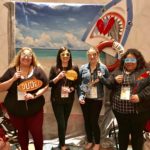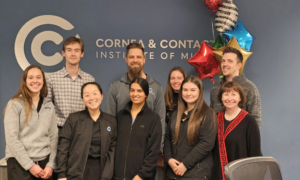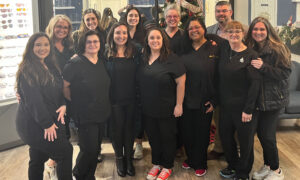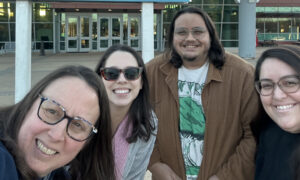By Michele Quintero, OD
March 17, 2021

Your staff are your patients’ primary contact and experience with your office. If they are not performing well in their jobs, there is a good chance many of your patients will decide to go elsewhere for their eyecare needs. Here are a few of the most impactful things we do to create a staff well primed to care for patients and help us grow revenues.
Invest in Staff Development: Sponsor Employee Participation in an Educational Event
For the past several years I have taken my entire staff to the Texas Optometric Association (TOA) in Austin. I pay for their registration for CE and exhibit hall access, hotels, transportation and all meals. They go to classes during the day and then we meet for dinner to discuss what they learned and how we can apply those principles in our office. I also give them free time to explore the city and have fun.
Bringing all of my employees to an educational event, and paying for all their expenses, shows them that I believe they are important, and that I want them to learn and grow with my practice. In addition, it shows staff that it is crucial to always continue learning, and looking for ways to improve and be better than we were the day, month, or year, before. TOA has great continuing education for staff to delve deeper and learn more about many topics. I’ve always been a big believer in educating staff to understand the “why” behind everything we do.
For example, I want them to understand why we check pupils, and why we do a 24-2 visual field instead of a 10-2 on a particular patient. Having that deeper understanding makes them better technicians, and that translates to a better patient experience. In addition, understanding why each step of pretesting is important helps the technician stay focused and engaged in what they are doing, versus just going through the motions or “checking” a box. Patients can tell when a staff member really cares and enjoys their job, which also equates to a better patient experience. In our office, the goal is to always “wow” the patient and make them feel as if they are the most important person on the planet while they are in our office. Having highly educated and engaged employees goes a long way toward accomplishing that.
There is a cost involved in paying all expenses for staff to travel out of town, but we are fortunate that Austin is a short drive from where we are located in Houston. Taking staff to your state association convention is a great way to make them feel valued, and it is more economical than taking them to other optometry meetings that require air travel. You can spend as little or as much as you want on employees’ meals and accommodations. However, I like to have my staff stay at the same hotel that I do, and I treat them to at least two fine-dining experiences during their stay. I do this for two reasons: One, because I want them to know how much I value them, and two, because I want them to experience the way luxury brands treat customers so they can then provide our patients with that higher level of service.
Having a better trained staff helps the practice become more profitable by allowing the patient to have a better experience. This will make the patient likelier to follow your treatment plans and spend more money with the practice, and will increase your word-of-mouth referrals. I have been taking the staff to the TOA for the past four years, and since I started taking them, our word-of-mouth referrals have increased steadily every year.

Dr. Quintero and her staff at a team-building event. Dr. Quintero says events like this help employees to get know each other better, encouraging a cooperative work style.
Team-Building
I use team-building exercises to build trust and personal connections between staff. Team-building activities can be as quick and simple as playing a game after a weekly office meeting, going out to happy hour together, or more involved, such as doing a weekend retreat. Try different forms of team-building to see what works best for your practice. One of our favorite activities was going out for Houston Restaurant Weeks. The staff would get together and pick the restaurant they wanted to try, and I would treat everyone to dinner.
Another team-building exercise I like to do with my staff is an escape room. It’s a lot of fun, and a great activity to do with staff because it helps everyone work together, and usually each person is able to find a clue and feel like they contributed to the team’s escape.
Team-building activities don’t have to be time-consuming or elaborate to be effective. Any time spent together outside the office having fun is a great way to build connections.
Having employees who trust one another, and can work cooperatively, is critical to forming a cohesive team that runs smoothly and efficiently. This enables everyone to work together as one unit to achieve our office’s goals and provide patients with the best experience possible. When there is a lack of trust, miscommunication or hostility among staff, patients pick up on it, and tasks start falling through the cracks. For example, contact lens or eyewear orders may not get placed on time or work items may be misplaced. These mishaps will ultimately affect the patient experience.
When you eliminate mistrust and hostility and have a staff that trusts, communicates and works well together, it is like having a well-oiled machine running at maximum efficiency. The staff will be happy and the patients will be happy. And if something does happen to fall through the cracks, the staff can work together to resolve the issue as quickly as possible.
Training Manual
Training manuals are great for on-boarding new hires. It will make your life, and that of your office manager and new hire, much easier. I opened my practice in 2005 and created a training manual two years later. I wish I had done it sooner. My office manager, who has been with me for the past 11 years, and I, are continually updating it.
Other Articles to Explore
The training manual will enable you to hire someone with zero optical experience and train them to do things the same way as the rest of the staff. This helps ensure the office culture is passed on to the new employee in a clear and concise manner. It will also give the new employee something to refer back to when needed, and will help existing employees remember how to do tasks they may not have done in a while. Training manuals help work processes remain consistent across all employees. This consistency will ensure each patient is treated with the same high level of customer service.
Our office manual starts with common terms and abbreviations used in optometry. It takes the new hire through how to do everything from pretesting to verifying and filing insurance, explains how to use our EHR, and how to discuss frame and lens options with patients. It is an invaluable tool for our new hires.
In creating your first training manual, start slowly and do a little at a time. Start by documenting one aspect of training and gradually build on that. Another great way to get started is to assign different segments of new-hire training to team members. The training manual can then be a compilation of each team member’s contribution, which you continually adjust and add to.
 Michele Quintero, OD, is the owner of two cold-start practices: Lakeshore Eye Care located in Cypress, Texas, and Advances in Vision located in Houston.
Michele Quintero, OD, is the owner of two cold-start practices: Lakeshore Eye Care located in Cypress, Texas, and Advances in Vision located in Houston.



























